british
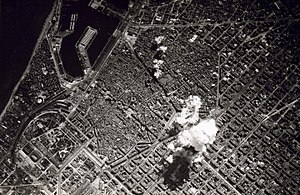 Sometimes, in researching weapons of war, and especially during World War II, I am shocked and horribly saddened by the ability of man to impose new and horrific means of death upon their enemies…simply because they disagree about how things should be run. During World War II, and possibly earlier, the killing method of Carpet bombing, also known as saturation bombing, came into practice. Carpet bombing is just what you would expect, “a large area bombardment done in a progressive manner to inflict damage in every part of a selected area of land.” Instantly, a picture of multiple explosions, the destruction of large areas of a town, or the entire town, come to mind. Mass casualties are expected. This is the way war is waged when hate reigns, but then most wars these days or even in the World War II era were filled with hate.
Sometimes, in researching weapons of war, and especially during World War II, I am shocked and horribly saddened by the ability of man to impose new and horrific means of death upon their enemies…simply because they disagree about how things should be run. During World War II, and possibly earlier, the killing method of Carpet bombing, also known as saturation bombing, came into practice. Carpet bombing is just what you would expect, “a large area bombardment done in a progressive manner to inflict damage in every part of a selected area of land.” Instantly, a picture of multiple explosions, the destruction of large areas of a town, or the entire town, come to mind. Mass casualties are expected. This is the way war is waged when hate reigns, but then most wars these days or even in the World War II era were filled with hate.
In the European Theatre, the first city to suffer heavily from aerial bombardment was Warsaw, on September 25, 1939. Achieving the results they wanted, the Germans continued this trend in warfare with the Rotterdam Blitz…an aerial bombardment of Rotterdam by 90 bombers of the German Air Force on May 14, 1940, during the German invasion of the Netherlands. The objective was to support the German assault on the city, break Dutch resistance, and force the Dutch to surrender. So in the middle of a ceasefire, they dropped the bombs anyway, destroying almost the entire historic city center, killing nearly nine hundred civilians and leaving 30,000 people homeless. That was still not enough for the Nazis. The Oberkommando der Luftwaffe (OKL) used the destructive success of the bombing to threaten to destroy the city of Utrecht, if the Dutch government did not surrender. The Dutch surrendered early the next morning.
With the actions of the Nazis, the British knew that they had to act. The Battle of Britain developed from a fight for air supremacy into the strategic and aerial bombing of London, Coventry and other British cities. The British built up the RAF Bomber Command in retaliation for the bombings, which was capable of delivering many thousands of tons of bombs onto a single target, in spite of heavy initial bomber casualties in 1940. The plan was to break German morale and obtain the surrender which Douhet had predicted 15 years earlier. Then the 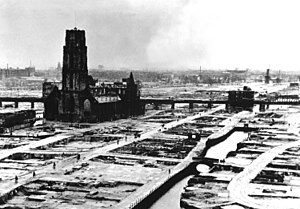 United States joined the war and the USAAF greatly reinforced the campaign, bringing in the Eighth Air Force into the European Theatre.
United States joined the war and the USAAF greatly reinforced the campaign, bringing in the Eighth Air Force into the European Theatre.
Still, that meant that the Allies would have to play the same game the Nazis had played. Many cities, both large and small, were virtually destroyed by Allied bombing. Cologne, Berlin, Hamburg and Dresden are among the most infamous, the latter two developing firestorms. I suppose the Germans finally found out what their own horrific tactics had done. Carpet bombing was also used as close air support (as “flying artillery”) for ground operations. The massive bombing was concentrated in a narrow and shallow area of the front (a few kilometers by a few hundred meters deep), closely coordinated with the advance of friendly troops. The first successful use of the technique was on May 6, 1943, at the end of the Tunisia Campaign. Carried out under Sir Arthur Tedder, it was hailed by the press as Tedder’s bomb-carpet (or Tedder’s carpet). The bombing was concentrated in a four by three-mile area, preparing the way for the First Army. This tactic was later used in many cases in the Normandy Campaign.
Carpet bombing was used extensively against Japanese civilian population centers, such as Tokyo, in the Pacific War. On the night of March, 9-10, 1945, 334 B-29 Superfortress heavy bombers were directed to attack the most heavily populated civilian sectors of Tokyo. Over 100,000 people burned to death in just one night from a heavy bombardment of incendiary bombs, comparable to the wartime number of US casualties in the entire Pacific theater. Another 100,000 to one million Japanese were left homeless. Similar attacks against Kobe, Osaka, and Nagoya, as well as other sectors of Tokyo followed, where over 9,373 tons of incendiary bombs were dropped on civilian and military targets. By the time of the dropping of the atomic bombs on Hiroshima and Nagasaki, light and medium bombers were being directed to bomb targets of convenience, because most urban areas had already been destroyed. In the 9-month long civilian bombing campaign, over 400,000 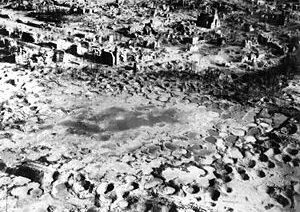 Japanese civilians died.
Japanese civilians died.
Carpet bombing of cities, towns, villages, or other areas containing a concentration of civilians is considered a war crime as of Article 51 of the 1977 Protocol I of the Geneva Conventions. Sometimes, that might make the nations think twice, but some nations, like the German Third Reich, think they can get away with anything. Hitler was crazy, and after deciding on the “Final Solution,” what is a little bit of Carpet Bombing in the mix. Carpet bombing was a horrible use of force, and in World War II and other wars since, it has taken many lives, and in the wrong hands it’s even worse.
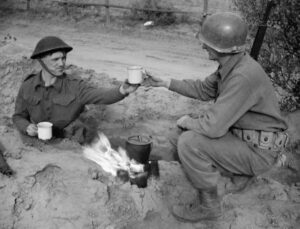 When you think of an army tank, the last thing on your mind is a way to make tea, but that became foremost in the minds of the designers of the British tanks. The Brits are well known for drinking their tea, and during World War II, that became a big problem. Apparently the enemy knew about this time-honored tradition, and took advantage of the soldiers who participated in it. During the war years, tea can be documented as being to blame for the loss of approximately 30 British tanks. The men had to exit the tank to brew their tea, and the tanks were then wide open for attack. Something had to be done.
When you think of an army tank, the last thing on your mind is a way to make tea, but that became foremost in the minds of the designers of the British tanks. The Brits are well known for drinking their tea, and during World War II, that became a big problem. Apparently the enemy knew about this time-honored tradition, and took advantage of the soldiers who participated in it. During the war years, tea can be documented as being to blame for the loss of approximately 30 British tanks. The men had to exit the tank to brew their tea, and the tanks were then wide open for attack. Something had to be done.
During World War II there was not time to get this all worked out, but in 1945, all British tanks were equipped with tea-making facilities. The British high command realized that if tank crews could make their tea on the go, then they wouldn’t be susceptible to being “caught with their pants down and their kettles out” by the enemy. So, since the British Centurion MBT (main battle tank) was introduced in late 1945, all British tanks and most AFVs (armored fighting vehicles) have been equipped with tea making facilities. The official name of the unit was Vessel Boiling Electric, but it is usually abbreviated to Boiling Vessel (BV). Unofficially, it was known as a kettle or bivvie. The BV is a square, watertight container which holds one gallon of water. The BV device draws power from the vehicle’s electricity supply and permits the crew not only to make tea, but also boil water or cook food…making their time on the battlefield much safer.
Of course, the BV unit had other important uses too, such as allowing the vehicle’s crew to produce hot water 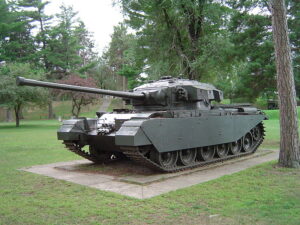 for washing or drinking purposes and simultaneously heat up canned food. The best part is that all of this can be done inside the vehicle itself, so the crew remains protected from enemy fire. That also protected them if there was danger of radioactive fallout or chemical weapons, which were considered a very real threat during the Cold War. It is now an official requirement for British AFVs to have a BV installed. This requirement is unique to the armed forces of the United Kingdom, and if you ask a British tank crew member what the most important part of the tank, they will tell you that it is the Vessel Boiling Electric, or the BV. Not only does it allow them to make their tea, but it keeps them safe when they are having a meal or drinking that tea.
for washing or drinking purposes and simultaneously heat up canned food. The best part is that all of this can be done inside the vehicle itself, so the crew remains protected from enemy fire. That also protected them if there was danger of radioactive fallout or chemical weapons, which were considered a very real threat during the Cold War. It is now an official requirement for British AFVs to have a BV installed. This requirement is unique to the armed forces of the United Kingdom, and if you ask a British tank crew member what the most important part of the tank, they will tell you that it is the Vessel Boiling Electric, or the BV. Not only does it allow them to make their tea, but it keeps them safe when they are having a meal or drinking that tea.
 The pilgrims were not the only people who did not like, or accept, British rule. When the French sold some of their territory to the British, the Indian tribes in these areas were not happy about the new regime. The French had more or less left them alone to do as they chose, and so they tended to live in relative peace, but the British were a different kind of rule, and the Indians felt that they were far less conciliatory than their predecessors. It wasn’t that the French and the Indians got along well, after all they had just ended the French and Indian Wars in the early 1760s. It was simply that the British were more demanding and less giving in the area of the Indian rights, than the French had been.
The pilgrims were not the only people who did not like, or accept, British rule. When the French sold some of their territory to the British, the Indian tribes in these areas were not happy about the new regime. The French had more or less left them alone to do as they chose, and so they tended to live in relative peace, but the British were a different kind of rule, and the Indians felt that they were far less conciliatory than their predecessors. It wasn’t that the French and the Indians got along well, after all they had just ended the French and Indian Wars in the early 1760s. It was simply that the British were more demanding and less giving in the area of the Indian rights, than the French had been.
As the matter became more and more heated, an Ottawan Indian chief named Pontiac decided that it was time for the Indian tribes to rebel. So, he called together a confederacy of Native warriors to attack the British force at Detroit. In 1762, Pontiac enlisted support from practically every tribe from Lake Superior to the lower Mississippi for a joint campaign to expel the British from the formerly French-occupied lands. According to Pontiac’s plan, each tribe would seize the nearest fort and then join forces to wipe out the undefended settlements. In April 1763, Pontiac convened a war council on the banks of the Ecorse River near Detroit. It was decided that Pontiac and his warriors would gain access to the British fort at Detroit under the pretense of negotiating a peace treaty, giving them an opportunity to seize forcibly the arsenal there. However, British Major Henry Gladwin learned of the plot, and the British were ready when Pontiac arrived in early May 1763, and Pontiac was forced to begin a siege. His Indian allies in Pennsylvania began a siege of Fort Pitt, while other sympathetic tribes, such as the Delaware, the Shawnees, and the Seneca, prepared to move against various British forts and outposts in Michigan, New York, Pennsylvania, Maryland and Virginia, at the same time. After failing to take the fort in their initial assault, Pontiac’s forces, made up of Ottawas and reinforced by Wyandots, Ojibwas and Potawatamis, initiated a siege that would stretch into months.
A British relief expedition attacked Pontiac’s camp on July 31, 1763. They suffered heavy losses and were repelled in the Battle of Bloody Run. However, they did succeeded in providing the fort at Detroit with reinforcements and supplies. That victorious battle allowed the fort to hold out against the Indians into the fall. Also holding on were the major forts at Pitt and Niagara, but the united tribes captured eight other fortified posts. At these forts, the garrisons were wiped out, relief expeditions were repulsed, and nearby frontier settlements were destroyed.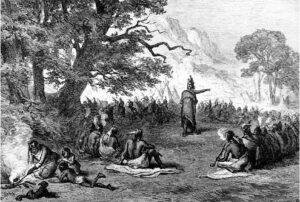
Two British armies were sent out in the spring of 1764. One was sent into Pennsylvania and Ohio under Colonel Bouquet, and the other to the Great Lakes under Colonel John Bradstreet. Bouquet’s campaign met with success, and the Delawares and the Shawnees were forced to sue for peace, breaking Pontiac’s alliance. Failing to persuade tribes in the West to join his rebellion, and lacking the hoped-for support from the French, Pontiac finally signed a treaty with the British in 1766. In 1769, he was murdered by a Peoria tribesman while visiting Illinois. His death led to bitter warfare among the tribes, and the Peorias were nearly wiped out.
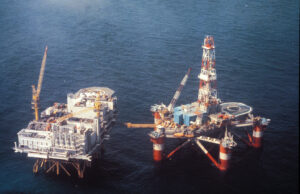 Apartment living is something many people do, and while they might dream of a house, or even have one, there can be reasons for having an apartment too. The oilfield would be one example of the need for a second place to live. Often, oil field workers must travel to the worksite. Once there, they have to stay there for a time, because traveling to and from home twice a day is just not feasible. Many oilfield companies provide living quarters for their employees. Sometimes it is a local motel, sometimes apartments, and sometimes, as with off shore drilling operations, companies must get innovative.
Apartment living is something many people do, and while they might dream of a house, or even have one, there can be reasons for having an apartment too. The oilfield would be one example of the need for a second place to live. Often, oil field workers must travel to the worksite. Once there, they have to stay there for a time, because traveling to and from home twice a day is just not feasible. Many oilfield companies provide living quarters for their employees. Sometimes it is a local motel, sometimes apartments, and sometimes, as with off shore drilling operations, companies must get innovative.
Some living quarters for oil field workers is quite a bit different than 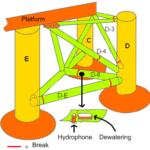 others. The Edda oil rig in the Ekofisk field, 235 miles east of Dundee, Scotland had just such an unusual housing arrangement for the employees who worked on the Edda oil rig. The Alexander Kielland platform was a floating apartment unit that housed 208 people. The floating apartment complex was located in the North Sea. The majority of the Phillips Petroleum workers were from Norway, but a few were American and British. The platform was held up by two large pontoons. It had bedrooms, kitchens, and lounges, and provided a place for workers to spend their time when not working. It was truly a comfortable home away from home…for the most part.
others. The Edda oil rig in the Ekofisk field, 235 miles east of Dundee, Scotland had just such an unusual housing arrangement for the employees who worked on the Edda oil rig. The Alexander Kielland platform was a floating apartment unit that housed 208 people. The floating apartment complex was located in the North Sea. The majority of the Phillips Petroleum workers were from Norway, but a few were American and British. The platform was held up by two large pontoons. It had bedrooms, kitchens, and lounges, and provided a place for workers to spend their time when not working. It was truly a comfortable home away from home…for the most part.
On March 30, 1980, at about 6:30pm most of the residents were in the platform’s small theater watching a movie. There was a storm brewing, but although there were gale conditions in the North Sea that evening, no one was expecting that a large wave would collapse and capsize the platform. Everything happened very fast. 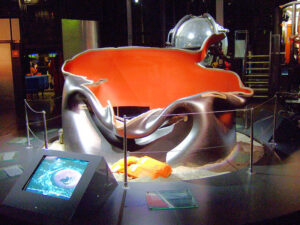 The wave hit, and things began to collapse. Within 15 minutes of the collapse, the floating apartment complex had capsized. It was so fast that many of the workers were unable to make it to the lifeboats. The Royal Air Force of Great Britain and Norwegian military both immediately sent rescue helicopters, but the poor weather made it impossible for them to help. Of the 208 people onboard, 123 drowned. The nightmare scenario seemed impossible, but a subsequent investigation revealed that there was a previously undetected crack in one of main legs of the platform. That had caused the structure’s disastrous collapse. The Alexander Kielland sat in the water for three years before it was salvaged.
The wave hit, and things began to collapse. Within 15 minutes of the collapse, the floating apartment complex had capsized. It was so fast that many of the workers were unable to make it to the lifeboats. The Royal Air Force of Great Britain and Norwegian military both immediately sent rescue helicopters, but the poor weather made it impossible for them to help. Of the 208 people onboard, 123 drowned. The nightmare scenario seemed impossible, but a subsequent investigation revealed that there was a previously undetected crack in one of main legs of the platform. That had caused the structure’s disastrous collapse. The Alexander Kielland sat in the water for three years before it was salvaged.

 The port city of my birth, Superior, Wisconsin was founded on November 6, 1854 and incorporated March 25 1889. The city’s slogan soon became, “Where Sail Meets Rail,” because it was port connection between the shipping industry and the railroad. Much of Superior’s history parallels its sister city of Duluth’s, but Superior has been around longer than Duluth, which is also known as the Zenith City. Of course, the area had people there before that…there were Ojibwe Indians, and French traders that are known to be in the area in the early 1600s.
The port city of my birth, Superior, Wisconsin was founded on November 6, 1854 and incorporated March 25 1889. The city’s slogan soon became, “Where Sail Meets Rail,” because it was port connection between the shipping industry and the railroad. Much of Superior’s history parallels its sister city of Duluth’s, but Superior has been around longer than Duluth, which is also known as the Zenith City. Of course, the area had people there before that…there were Ojibwe Indians, and French traders that are known to be in the area in the early 1600s.
After the Ojibwe settled in the area and set up an encampment on present-day Madeline Island, the French started arriving. In 1618 voyageur Etienne Brulé paddled along Lake Superior’s south shore where he encountered the Ojibwe tribe, but he also found copper specimens. Brulé went back to Quebec with the copper samples, and a glowing report of the region. French traders and missionaries began settling the area a short time later, and a Lake Superior tributary was named for Brulé. Father Claude Jean Allouez, was one of those missionaries. His is often credited with the development of an early map of the region. Superior’s Allouez neighborhood takes its name from the Catholic missionary. The area was developed quickly after that, and by 1700 the area was crawling with French traders. The French traders developed a good working relationship with the Ojibwe people.
The Ojibwe continued to get along well with the French, but not so much the British, who ruled the area after 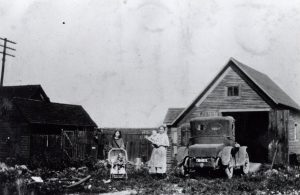
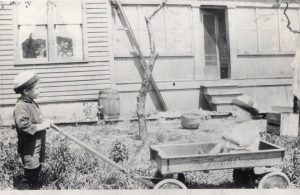 the French, but that ended with the America Revolution and the Treaty of Peace in 1783. The British weren’t as good to the Ojibwe as the French had been. Treaties with the Ojibwe would give more territory to settlers of European descent, and by 1847 the United States had taken control of all lands along Lake Superior’s south shore.
the French, but that ended with the America Revolution and the Treaty of Peace in 1783. The British weren’t as good to the Ojibwe as the French had been. Treaties with the Ojibwe would give more territory to settlers of European descent, and by 1847 the United States had taken control of all lands along Lake Superior’s south shore.
In 1854 the first copper claims were staked at the mouth of the Nemadji River…some say it was actually 1853. The Village of Superior became the county seat of the newly formed Douglas County that same year. The village grew quickly and within two years, about 2,500 people called Superior home. Unfortunately, with the financial panic of 1857, the town’s population stagnated through the end of the Civil War. The building of the Duluth Ship Canal in 1871, which was followed by the Panic of 1873. pretty much crushed Superior’s economic future. Things began to look up when in 1885, Robert Belknap and General John Henry Hammond’s Land and River Improvement Company established West Superior. Immediately they began building elevators, docks, and industrial railroads. In 1890, Superior City and West Superior merged, The city’s population fluctuated, as a boom town will, between 1887 and 1893, and then another financial panic halted progress. Over the years since then, Superior’s population has had it’s ups and down, as has it’s sister city, Duluth, but it has remained about one fourth the size of its twin across the bay.
My great grandparents, Carl and Albertine Schumacher lived in the Goodhue, Minnesota area, when my grandmother Anna was born, but my grandparents Allen and Anna Spencer lived in Superior. That is where my 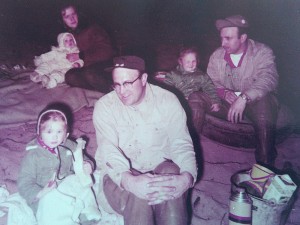
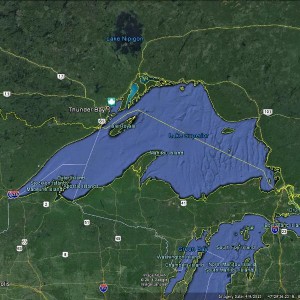 dad, Allen Spencer was born, as were my sister, Cheryl and I. We didn’t live in Superior for all of our lives, just 3 and 5 years, but the area remains in our blood, and in our hearts. It could be partly because of all the trips our family made back to Superior, but I don’t think that’s totally it, because there is just something about knowing that you came from a place, that will always make it special. Superior, Wisconsin is a very special place, that will always be a part of me and my sister, Cheryl too.
dad, Allen Spencer was born, as were my sister, Cheryl and I. We didn’t live in Superior for all of our lives, just 3 and 5 years, but the area remains in our blood, and in our hearts. It could be partly because of all the trips our family made back to Superior, but I don’t think that’s totally it, because there is just something about knowing that you came from a place, that will always make it special. Superior, Wisconsin is a very special place, that will always be a part of me and my sister, Cheryl too.
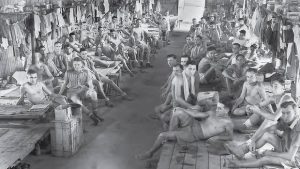 As we all know, being a prisoner of war is not a safe place to be. Growing us watching shows like “Hogan’s Heroes” gave the impression that the enemy was always nice to their prisoners, and that being in a POW camp was ok, but that wasn’t the reality of those camps. Of course, in the days of “Hogan’s Heroes” violence was just not shown on television. The world was a different place…at least for the people back home watching it on television. The reality of the POW camps was much different, as many of us have seen in newer shows about prisoners during wars. We have witnessed some of the atrocities that have been done…and we still aren’t seeing the true story, I don’t suppose.
As we all know, being a prisoner of war is not a safe place to be. Growing us watching shows like “Hogan’s Heroes” gave the impression that the enemy was always nice to their prisoners, and that being in a POW camp was ok, but that wasn’t the reality of those camps. Of course, in the days of “Hogan’s Heroes” violence was just not shown on television. The world was a different place…at least for the people back home watching it on television. The reality of the POW camps was much different, as many of us have seen in newer shows about prisoners during wars. We have witnessed some of the atrocities that have been done…and we still aren’t seeing the true story, I don’t suppose.
One example of the true story is the Sandakan Death March. For some reason, when the Japanese were close to getting caught in their brutality, they decided that the best thing to do was to take the prisoners on a march deeper into the jungle so that the evidence of their torture was not found. In reality, they could have just left the prisoners in the camp…abandoned them, and they would have likely never been caught, but apparently it was more about retaliation over their loss in the war. One such march was the Bataan Death March in the Philippians and the deadly construction of the rail line linking Burma with Thailand.
Similar to that was the Sandakan Death March in Malaysia. It is not as well known, and in fact many Australians would like it to be removed from history…not from the history books, but they wish it had never happened at all. I can fully understand that, once I found out what the Sandakan Death March was all about. Still, I don’t understand why more people don’t know about it. There were 2,700 British and Australian prisoners of war interned there by Japanese forces, as the end of World War II 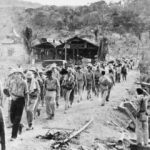 approached. The Sandakan Death March has been called that Australia’s worst military tragedy.
approached. The Sandakan Death March has been called that Australia’s worst military tragedy.
Sandakan was a brutal place. About 900 British soldiers were among the prisoners of war brought to Sandakan. Most of them did not survived. Prisoners interned here died slowly. They were starved and beaten. Toward the end of the war, when the Japanese decided to flee Sandakan, most of the remaining prisoners were marched to their deaths. Those who were strong enough to make it to the end of the trail were executed. Only six…a man named Owen Campbell and five others survived…and then only because they escaped. Campbell is the last living survivor, and a reminder that when war veterans pass away, a little piece of history dies with them. That is the saddest part of such horrific loss. When people forget about the atrocities of the past, the world is destined to repeat them. When life is viewed as so insignificant, then killing becomes easy, and the consequences of these killings is somehow pushed aside and even justified. That should never be allowed to happen…not in the POW camps, or in the streets of our cities. Bruce Scott, Australia’s minister for veterans affairs, referring to the prison guards at Sandakan said, “The proud and honorable title of soldier cannot be applied to those men.” The guards forced the prisoners to begin the death march from the camp at Sandakan as the Allies were approaching. The men were already very weak from being starved and beaten. Most of the men did not survive the march…succumbing to their conditions along the way. Those that survived the march were simply executed when they reached the end of the journey. That was even more brutal than the march itself.
Campbell returned to Borneo for a ceremony in March of 1999, back to the jungles where half a century ago his 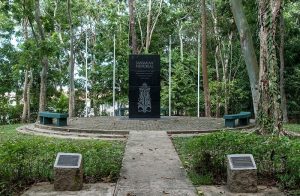 best mates were marched to their deaths. Wearing a row of ribbons and medals across his left breast pocket, Mr. Campbell, aged 82, stared straight ahead at a black slab of granite, a memorial to one of the most horrific…yet little-known…atrocities of World War II in the Pacific. “We come here to this place to help ensure that this story is not forgotten,” Bruce Ruxton, an Australian veteran, told the crowd assembled at the memorial site. “We acknowledge that great evil was done here, that inhumanity here reached such depths that shame us as human beings even to contemplate.” In a sign of the continuing sensitivities and anger surrounding the prison camp and death march, no Japanese were present at the ceremony.
best mates were marched to their deaths. Wearing a row of ribbons and medals across his left breast pocket, Mr. Campbell, aged 82, stared straight ahead at a black slab of granite, a memorial to one of the most horrific…yet little-known…atrocities of World War II in the Pacific. “We come here to this place to help ensure that this story is not forgotten,” Bruce Ruxton, an Australian veteran, told the crowd assembled at the memorial site. “We acknowledge that great evil was done here, that inhumanity here reached such depths that shame us as human beings even to contemplate.” In a sign of the continuing sensitivities and anger surrounding the prison camp and death march, no Japanese were present at the ceremony.
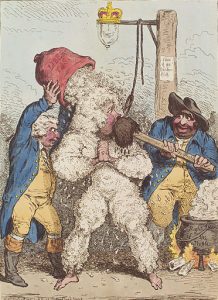 I think most of us have heard of being “tarred and feathered,” as a form of punishment, but we may not really know how much of a punishment it really was. When we think about it, the show, “Home Alone” might come to mind. Of course, some kind of syrup and then the feathers, but that does not really even begin to describe the real act of tarring and feathering.
I think most of us have heard of being “tarred and feathered,” as a form of punishment, but we may not really know how much of a punishment it really was. When we think about it, the show, “Home Alone” might come to mind. Of course, some kind of syrup and then the feathers, but that does not really even begin to describe the real act of tarring and feathering.
In 1776 in Norfolk, Virginia, Captain William Smith was tarred and feathered by a mob which actually included the mayor of Norfolk apparently!! Mobs are never a good thing. They are always out of control, and people who might normally be pretty decent, are dragged into things they might never do otherwise. Captain Smith was suspected of sharing secrets about a local ship owner John Gilcrest smuggling goods, with British officials. It was a terrible offence, but remember that he was “suspected” of this, not convicted. That is the problem with the mobs. They often take matters into their own hands…Vigilante Justice…whether the person is really guilty or not.
Tar and Feather was a medieval form of torture and humiliation. It involved stripping the victim up to his waist, applying tar on his body, and covering him with feathers. That wasn’t the end of it though. The victim was then put on a cart and paraded around the place. Sometimes, the tar was simply poured on the victim’s body and he was made to roll on feathers. This isn’t like syrup or the asphalt tar of today. The tar they used was likely from the pine tar the Colonies were accustomed to distilling for its use on preserving the wood of ships from rot. Hot asphalt tar would critically burn the body. Pine creates charcoal and pine tar when heated up. This pine tar is naturally a sticky substance making it a perfect material for applying to someone who is about to be covered in 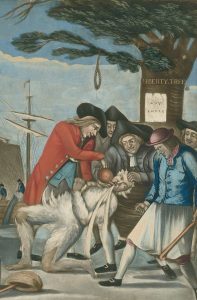 feathers. While that explains why there were no casualties of this form of punishment. Nevertheless, the job of removing the dried pine tar and feathers off the skin was extremely painful.
feathers. While that explains why there were no casualties of this form of punishment. Nevertheless, the job of removing the dried pine tar and feathers off the skin was extremely painful.
After Captain Smith was humiliated by the application of his feathery outfit, he was thrown into the harbor. He almost drowned before being rescued by a passing ship, just as his strength was giving out. He survived, and was later quoted as saying that “…[they] dawbed my body and face all over with tar and afterwards threw feathers on me.” As with most other tar and feathers victims in the decade that followed, Smith was suspected of informing on smugglers to the British Customs service. The punishment was harsh, and it was swift. The colonies were trying to gain their freedom, and that meant that they would fight to the death, and they would never tolerate traitors. I don’t know if Captain Smith was a traitor or not, but no one was ever punished for what they did to him, so there is that.
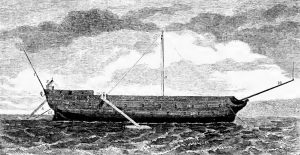 I am sometimes amazed at the ability of humans to be heinously cruel to other human beings. From murders, to slave owners, to prisons or prisoner of war camps, man has the ability to act out evil in its purest form. Still, one would not have expected such evil in the American Revolutionary War era. Well, one would be wrong. We all know that war is a horrific event, but worse than losing life and limb in battle, seems to be the fate faced by those who are captured by the enemy forces, only to be tortured and even killed.
I am sometimes amazed at the ability of humans to be heinously cruel to other human beings. From murders, to slave owners, to prisons or prisoner of war camps, man has the ability to act out evil in its purest form. Still, one would not have expected such evil in the American Revolutionary War era. Well, one would be wrong. We all know that war is a horrific event, but worse than losing life and limb in battle, seems to be the fate faced by those who are captured by the enemy forces, only to be tortured and even killed.
During the Revolutionary War, being captured by the British often meant being sent to a prison ship, the worse of which was the HMS Jersey. Over the years of the war, approximately 11,000 prisoners of war perished on the HMS Jersey. The number of American field casualties during that war was approximately 4,500. That is a stunning difference. The HMS Jersey often held thousands of prisoners at one time, in quarters that were so close, that it could be likened to being packed in like sardines in a tin. There was no light, no medical care, barely any oxygen, and very little in the way of food and clean water. The guards on the prison ships were not concerned with keeping their prisoners alive, and HMS Jersey was the worst of them all.
The little food the prisoners were given was moldy, putrefied, and worm infested. The prisoners had to choose daily to eat the horrible food, or starve. One prisoner Ebenezer Fox, who survived said, “The bread was mostly mouldy, and filled with worms. It required considerable rapping upon the deck, before these worms could be dislodged from their lurking places in a biscuit. As for the pork, we were cheated out of it more than half the time, and when it was obtained one would have judged from its motley hues, exhibiting the consistence and appearance of variegated soap, that it was the flesh of the porpoise or sea hog, and had been an inhabitant of the ocean, rather than a sty. The provisions were generally damaged, and from the imperfect manner in which they were cooked were about as indigestible as grape shot.” That pretty much says it all, I would say. The British soldiers were seemingly unaffected by the image of prisoners banging their biscuits against the deck to remove worms, because this treatment continued throughout the conflict.
Because the prisoners were kept at sea, the smell of a piece of dirt from the shoes of a soldier back from shore leave became one of the prisoners’ greatest delights. I guess that one can always find some good, even in the worst situations, if one looks for it. Captain Dring, a survivor who wrote prolifically about his experiences on the Jersey, recalled one particularly strange consolation. When someone died on the ship, their remains were usually thrown overboard, but occasionally they were allowed to be taken ashore and laid to rest. Dring was part of a group that was tasked with digging graves on land. The men chosen for this duty were ecstatic to be on land again. Dring even took off his boots simply to feel the earth underneath his feet. However, when the crew came across a piece of broken-up turf, they did something extraordinary: “We went by a small patch of turf, some pieces of which we tore up from the earth, and obtained permission to carry them on board for our comrades to smell them. Circumstances like these may appear trifling to the careless reader; but let him be assured that they were far from being trifles to men situated as we had been. Sadly did we approach and reenter our foul and disgusting place of confinement. The pieces of turf which we carried on board were sought for by our fellow prisoners, with the greatest avidity, every fragment being passed by them from hand to hand, and its smell inhaled as if it had been a fragrant rose.”
The known fate of the men on board the prison ships, and especially HMS Jersey was a slow and painful death. Most knew better than to expect to survive their ordeal. They had seen too many of their comrades die right before their eyes, to have much hope that they could make it out. To make mattes worse, the majority of the prisoners aboard the Jersey were young, inexperienced farmhands, not hardened soldiers with survival experience. Only a few of Washington’s army were soldiers with any 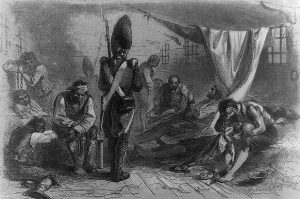 experience. The rest were provincial people, and many had never traveled beyond the limits of the small county where they lived. Imagine the horror of war, and then the conditions on HMS Jersey to the young, innocent men. The constant punishment, meager rations, lack of light, and lack of privacy could be tolerated, but the inactivity and helplessness most likely added depression and despair to their suffering. Times were different then, and there were things that were not available, but many of the things the prisoners suffered could have been avoided, especially the overcrowding and unsanitary conditions, but apparently they just didn’t care.
experience. The rest were provincial people, and many had never traveled beyond the limits of the small county where they lived. Imagine the horror of war, and then the conditions on HMS Jersey to the young, innocent men. The constant punishment, meager rations, lack of light, and lack of privacy could be tolerated, but the inactivity and helplessness most likely added depression and despair to their suffering. Times were different then, and there were things that were not available, but many of the things the prisoners suffered could have been avoided, especially the overcrowding and unsanitary conditions, but apparently they just didn’t care.
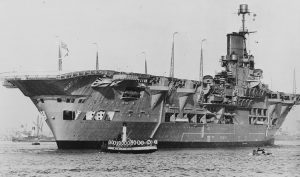
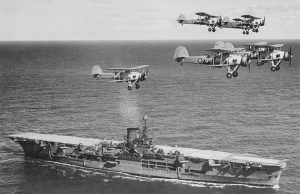 World War II brought with it necessary changes to war ships. Suddenly, the world had planes that could fly greater distances, and even had the ability to land on a ship, provided the ship was big enough to have a relatively short runway. I say relatively short, because the runways on ships seemed like they would be too short to safely land a plane, but they did. One such ship was the HMS Ark Royal.
World War II brought with it necessary changes to war ships. Suddenly, the world had planes that could fly greater distances, and even had the ability to land on a ship, provided the ship was big enough to have a relatively short runway. I say relatively short, because the runways on ships seemed like they would be too short to safely land a plane, but they did. One such ship was the HMS Ark Royal.
The Ark Royal was an English ship designed in 1934 to fit the restrictions of the Washington Naval Treaty. The ship was built by Cammell Laird at Birkenhead, England, and was completed in November 1938. The design of this ship differed from previous aircraft carriers, in that Ark Royal was the first ship on which the hangars and flight deck were an integral part of the hull, instead of an add-on or part of the superstructure. This ship was designed to carry a large number of aircraft. There were two hangar deck levels. HMS Ark Royal served during a period of time during which we first saw the extensive use of naval air power. The Ark Royal played an integral part in developing and refining several carrier tactics.
HNS Ark Royal served in some of the most active naval theatres of the World War II. The ship was involved in the first aerial and U-boat kills of the war, operations off Norway, the search for the German battleship Bismarck, and the Malta Convoys. After Ark Royal survived several near misses, she became known as a “lucky ship” and the reputation stuck…at least until November 13, 1941, when the German submarine U-81 torpedoed her and she sank the following day. Nevertheless, only one of her 1,488 crew members was killed. Her sinking was the subject of several inquiries. While only one man was killed, investigators still couldn’t figure out how the carrier was lost…in spite of efforts to tow her to the naval base at Gibraltar. In the end, they found that several design flaws contributed to the loss. These flaws were rectified in subsequent British carriers. There was, of course, no time to look for the ship then. The war was still going on.
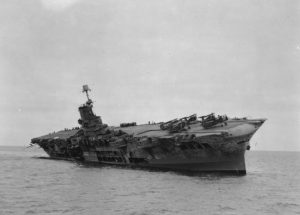
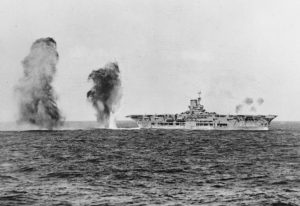
The wreck was discovered in December 2002 by an American underwater survey company using sonar mounted on an autonomous underwater vehicle. The company was under contract from the BBC for the filming of a documentary about the HMS Ark Royal. The ship was at a depth of about 3,300 feet and approximately 30 nautical miles from Gibraltar. So close, and yet so far away.
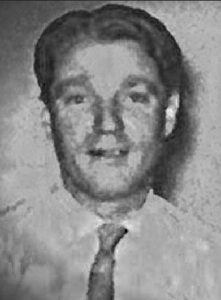 Most people have heard of, and seen, the James Bond movies. Of course, Bond is a fictional British agent, known as 007, and his character has been played by a number of actors over the years, but in reality, he is fictional. Renato Levi, who was also known as CHEESE, MR. ROSE, LAMBERT, EMILE, or ROBERTO, was a Jewish-Italian adventurer and double-agent for the British in World War II. Levi was instrumental in setting up a wireless transmitter in Cairo. The transmitter fed false information to the Axis powers over the course of the war. It was a great tool for the Allies. Unfortunately, Levi was captured and imprisoned shortly after he accomplished his mission. Levi’s “CHEESE” network helped to outflank Rommel at the battle of El Alamein in Egypt, as well as placing other, strategic misinformation that aided the Allies, including at Normandy.
Most people have heard of, and seen, the James Bond movies. Of course, Bond is a fictional British agent, known as 007, and his character has been played by a number of actors over the years, but in reality, he is fictional. Renato Levi, who was also known as CHEESE, MR. ROSE, LAMBERT, EMILE, or ROBERTO, was a Jewish-Italian adventurer and double-agent for the British in World War II. Levi was instrumental in setting up a wireless transmitter in Cairo. The transmitter fed false information to the Axis powers over the course of the war. It was a great tool for the Allies. Unfortunately, Levi was captured and imprisoned shortly after he accomplished his mission. Levi’s “CHEESE” network helped to outflank Rommel at the battle of El Alamein in Egypt, as well as placing other, strategic misinformation that aided the Allies, including at Normandy.
Levi almost always flew under the radar, especially in the British National Archives. Even in recent books about spies and counter-intelligence, the accomplishments of Renato Levi still receive barely a mention and the specifics about his part in all this is often confused. In all reality, Levi’s files have only recently been released, and even then Levi’s, aliases “Cheese,” “Lambert,” or “Mr. Rose” seem to be identified openly only once in his classified dossier. Indeed, in his national documents, there is evidence of redaction everywhere, including Levi’s primary codename “CHEESE” has been carefully handwritten in tiny, blocky letters over white-out, in order to re-establish a place in history.
The CHEESE network, out of Cairo, took a significant hit to its credibility when Levi was arrested and convicted in late 1941 or early 1942. The British came up with an imaginary agent. “Paul Nicossof” was able to regain and retain the trust of the Germans, which is one of the most interesting features of this story. Thanks to the expert manipulations of the British Intelligence operatives controlling the wireless, the CHEESE network was considered credible again by June of 1942…just in time for “A” Force to start planting counter-intelligence prior to the commencement of Operation Bertram at El Alamein in Egypt during October of 1942.
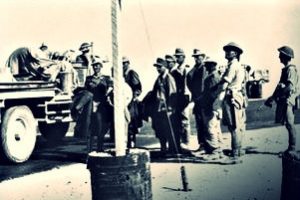 Most interesting to note are the ways that the intelligence operatives used payment schedules…or, rather, the German’s lack of payment to “Paul Nicossof”…to establish credibility about the fictitious informant’s information. “Nicossof” was portrayed as moody and inconsistent, because efforts to pay him were always unsuccessful. His “handlers” credited Germany’s inability to pay “Nicossof” as the way they were able to extend his character beyond the “impasse” that would normally constitute a non-military informant. “Nicossof” could portray himself as the “man who brought Rommel to Egypt,” which would get him paid for his troubles at last, as well as the glory and medals that went with it…all to a fictitious agent!!
Most interesting to note are the ways that the intelligence operatives used payment schedules…or, rather, the German’s lack of payment to “Paul Nicossof”…to establish credibility about the fictitious informant’s information. “Nicossof” was portrayed as moody and inconsistent, because efforts to pay him were always unsuccessful. His “handlers” credited Germany’s inability to pay “Nicossof” as the way they were able to extend his character beyond the “impasse” that would normally constitute a non-military informant. “Nicossof” could portray himself as the “man who brought Rommel to Egypt,” which would get him paid for his troubles at last, as well as the glory and medals that went with it…all to a fictitious agent!!
Perhaps because of the British Intelligence’s efforts to make “Nicossof” convincing and because Levi was so good under duress in prison, the Germans never really lost faith in the CHEESE operative network. They were starved for information, and CHEESE held the only promise for any intelligence about the Middle East. The Germans blamed the Italians for the confinement of their only key agent in the Middle East, Renato Levi. For whatever the reason, the Germans trusted Levi, but he never broke or compromised his duty to the Allied forces.
After looking at these newly declassified documents some people have tried to press Levi into the service of a “Hero Spy” figure, but in reality, Levi was a far more complicated figure and these whitewashed narratives don’t really tell the whole story of Levi’s complexity, nor the complexity of his work. Levi’s story also reveals much about the inner workings of the German Abwehr and the nature of the Italian Intelligence operations. Levi’s British handlers speculated that it was unlikely that the German and Italian Intelligence bureaus had a great deal of communication between them. The Germans were really overly satisfied with Levi’s original purpose of 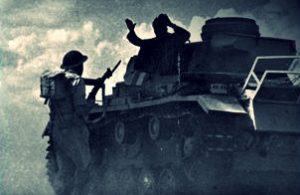 establishing a wireless transmitter network, to their detriment in the end.
establishing a wireless transmitter network, to their detriment in the end.
It seems that Levi’s ultimate fate is unknown. It is true that the CHEESE network was in full swing throughout the war, and many have credited “CHEESE” with hoodwinking the Germans in a big way on many occasions. Perhaps Levi was again affiliated with CHEESE after his release, or maybe not. Regardless, Renato Levi, who had always loved travel, intrigue, and a really good lie, did a remarkable service to the Allied forces by instituting one of the best and most productive counter-intelligence operations of World War II, and he kept it all safe.

